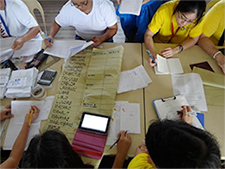Calm in a Storm
Graduate student Sako Narita provides disaster response in the Philippines
It was the middle of the night when Sako Narita received an urgent phone call from Japan with a request: a disaster response team headed for the Philippines after Typhoon Haiyan needed her expertise.
The call did not come as a surprise to Narita 04, interdisciplinary studies (international emergency health services), currently a masters student in emergency health services (EHS). She had prior experience providing disaster response for the 2011 earthquake and tsunami in her native Japan and a previous typhoon in the Philippines in 2012. This time, she had to be ready in a matter of days to travel with the Japan-based Humanitarian Medical Assistance (HuMA) disaster response team.
Narita spent ten days in the Philippines in November 2013 providing needs assessment: assisting patients, negotiating with local and international health and government organizations, setting up mobile medical clinics, and doing whatever she could to ensure typhoon victims received the care they needed.
Believe it or not, the people were more positive than we expected. Sometimes people were already moving onthey started a new life and started building new houses, says Narita. But deep inside, they still are struggling.
Negotiating Solutions
In addition to providing needs assessment and medical assistance, a big part of Naritas job was negotiationa skill she has developed through both hands-on experience and her EHS education at UMBC.
The on-the-ground situation during Naritas first mission in the Philippines in 2012 required her to negotiate with local officials to gain access to the disaster site for HuMA. During her more recent trip, she used her negotiation skills again to discuss partnering with an Israeli disaster response team that she previously worked with in Japan.
How did Narita feel prepared to serve in such a critical role? All of my knowledge about disaster response I got at UMBC, she reflects.
As a student from Japan interested in studying medicine and emergency health services, Narita says the decision to come to UMBC was easy given the EHS departments international reputation as a leader in its field.
What makes our program different from every other program is that our focus is on that area of overlap between public health and emergency management, explains Rick Bissell, EHS professor and graduate program director. The graduate program teaches emergency clinical response, management and public health, and prepares students like Narita to meet everyday and disaster-related emergency health needs in both domestic and international situations.
The Whole Person
The EHS department began at UMBC in 1980, following Marylands national leadership in developing a statewide emergency medical services program in the 1970s. The department historically has had strong relationships with agencies such as the Maryland Institute for Emergency Medical Services Systems (MIEMSS) and University of Maryland Shock Trauma Center, as well as several state, county and local emergency health service providers.
Those partners, who have played such an important role in providing training opportunities for EHS students, are now the beneficiaries of the EHS program. Today, alumni serve in a variety of roleslocally and around the globeas physicians, EMS directors and coordinators. Jonathan Bratt is the MIEMSS coordinator for region 5, which covers Montgomery, Prince Georges, Calvert, Charles and St. Marys counties. Christoph Redelsteiner served as chief of EMS for the Vienna, Austria Red Cross before joining the faculty of St. Pölten University of Applied Sciences in Austria. One alumnus, physician Matt Levy, has returned to UMBC to serve as EHS medical director.
We educate the whole person, says Bruce Walz, professor and chair of the EHS department. What weve heard back from employers is that our students know how to think. Theyre not just doing a protocol. They know why theyre doing that protocol, they know why theyre giving that drug and they can make those decisions in the field.
This priority on educating students as whole people is evident in the work of EHS alumni and students like Sako Narita, who is also a national registered paramedic and Maryland emergency medical technician-paramedic. The level of dedication and quality of work the programs graduates are known for propels them to the top of their field, while also having a palpable impact on patients lives and on communities in need.
HuMA could contact me again, Narita says, and I hope they do.
(03/21/2014)
Homepage image: © Herman Lumanog | Dreamstime.com

